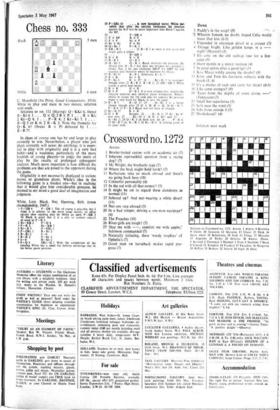Chess no. 333
Black White
5 men
6 men
C. Mansfield (1st Prize, Good Companions, 1914). White to play and mate in two moves; solution next week.
Solution to no. 332 (Haring): Q - KKt 6, threat R -Kt 4. 1 . . . Q X Q; 2 B x P. 1 . . . R x Kt; 2 Kt-Q 6. I P-R 4; 2 Kt-Kt 7. 1 ... B-Q 3 or K 6; 2 R - K 3. Note the thematic try Q-K 6? (threat B x P) defeated by I . . . B - B 7!
In chess of course one has by and large to play correctly to win. Nevertheless, a player who just plays correctly will never do anything; it is essen- tial to play with originality and it is a very bad habit-and a weakness, particularly of the more bookish of young players-to judge the merit of play by the results of prolonged subsequent analysis. Much more important is how difficult the problems are that are posed to the opponent during the game.
Originality is not necessarily displayed in violent moves or grandiose plans; White's idea in the following game is a modest one-but in realising that it would give him considerable pressure, he showed to my mind a good deal of imagination and judgment.
White, Lein. Black. Nej. Opening, Rai. (ussit championship, 1967.)
I P - QB 4 P - QB 3. This of course is playable, but I think it is inferior to the more usual moves; so often agamst slow opening play by White an early P - QB 4 by Black is good that it is a pity to commit oneself so soon to P - B 3.
2 Kt - KB 3 P - Q 4 3 P - K 3 Kt - KB 3 4 Kt - B 3 P - KKt 3 5 P -QKt 3 B - Kt 2 6 B- Kt 2 0-0 7 B- K 2 P - Kt 3 8 0- 0 B- Kt 2
9 P - q 4 QKt - Q 2 With the completion of the
opening White has a small but definite advantage due to his better pawn position. 10 P -QICt 41 . . . A very fanaghted move; White per. aka that after the eeseing ezehaeges Ma mu= against the KtP will be more important than Black's against the RP.
10 . . . P - QR 4 II P x RP RXP 12 P x P Kt X P 13 Kt X Kt P X Kt
14 Q- Kt 3 P - K 3
15 KR - B 1 . . . 15 B- B 3 at once is also good and might gain a tempo. IS . . . B -QR 3 16 B x 11 R X B 17 B - B 3 Q - R 1 I8 Q- Kt 5 Q - R I. Black overrates his position. He
should play It - R 2 but does not because he-wrongly- thinks that if he can exchange QKtP for QRP he will equalise and therefore mints to maintain his threat.
19 B - Kt 4! B - B I. Otherwise B - K 7.
20 13 x 13 Kt x B 21 P - Kt 3 It X P? 21 . . . Kt -0 2 is necessary though after 22 R - B 7. R - R 2; 23 QR - QB 1 White stands a good deal better. 22 R x R QXR 23 Q X P Q - R I. It is very striking that, despite the reduced material and identical pawn formations. White's ability to secure the 7th rank plus his superior Kt position make it very hard for Black to save the game. 24 R - 13 7 • R -Q 2? 24 . . . Q - Kt 1 is a better chance though after 25 Q x Q. R x Q; 26 Kt - K 5. P - B 4; 27 P - R 4 Black will still have to struggle.
25 Kt - K 5! RXR 260 x It • Resigns. 26. . . 0 - K I; 27 Kt-Kt 4! and now 27 . . . Kt -Q 2: 28 Q x Kt! and 27 . . . K - Kt 2; 28 Q - K 5 ch both lose. Or 26 . . . P - B 4; 27 Q - B 7 ch. K - R 128 Kt - B 6! A striking game in its quiet style.


































 Previous page
Previous page